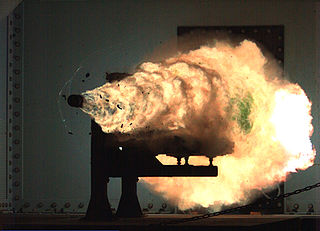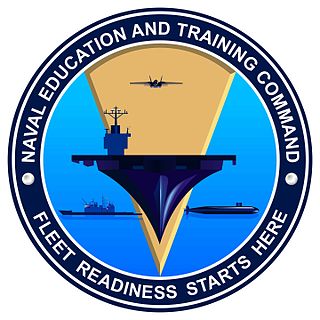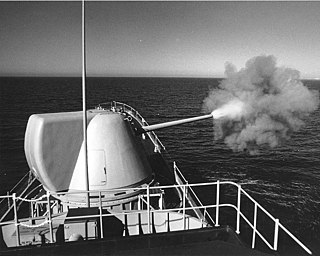
Redstone Arsenal is a United States Army base adjacent to Huntsville, Alabama in the Wheeler National Wildlife Refuge. A census-designated place in Madison County, Alabama, United States, it is part of the Huntsville-Decatur Combined Statistical Area. The Arsenal is a host to over 75 tenant agencies including the Department of Defense (DoD), Department of Justice (DOJ), the Federal Bureau of Investigation (FBI), and NASA's largest field center, the Marshall Space Flight Center.

Dahlgren is an unincorporated community and census-designated place (CDP) in King George County, Virginia, United States. The population was 2,946 at the time of the 2020 census, up from 2,653 at the 2010 census, and up from 997 in 2000.

A railgun or rail gun is a linear motor device, typically designed as a weapon, that uses electromagnetic force to launch high-velocity projectiles. The projectile normally does not contain explosives, instead relying on the projectile's high kinetic energy to inflict damage. The railgun uses a pair of parallel conductors (rails), along which a sliding armature is accelerated by the electromagnetic effects of a current that flows down one rail, into the armature and then back along the other rail. It is based on principles similar to those of the homopolar motor.

The Naval Undersea Warfare Center (NUWC) is the United States Navy's full-spectrum research, development, test and evaluation, engineering and fleet support center for submarines, autonomous underwater systems, and offensive and defensive weapons systems associated with undersea warfare. It is one of the corporate laboratories of the Naval Sea Systems Command. NUWC is headquartered in Newport, Rhode Island and has two major subordinate activities: Division Newport and Division Keyport in Keyport, Washington. NUWC also controls the Fox Island facility and Gould Island. It employs more than 4,400 civilian and military personnel, with budgets over $1 billion.
The Naval Ordnance Laboratory (NOL) was a facility in the White Oak area of Montgomery County, Maryland. It is now used as the headquarters of the U.S. Food and Drug Administration.

Naval Surface Warfare Center, Indian Head Division is a United States Navy installation in Charles County, Maryland. Part of Naval Sea Systems Command (NAVSEA), it is one of ten divisions of the Naval Surface Warfare Center (WFC). Its mission is to research, develop, test, evaluate, and produce energetics.
The Bureau of Ordnance (BuOrd) was a United States Navy organization, which was responsible for the procurement, storage, and deployment of all naval weapons, between the years 1862 and 1959.

Training Support Center Hampton Roads is, since 2004, the name of the facility in Virginia Beach, Virginia, USA, which was long-known as "FTC Dam Neck". It is the home of the Fleet Combat Training Center Atlantic of the United States Navy.

The Naval Education and Training Command (NETC) is an enterprise-level shore command of the United States Navy with more than 19,000 military and staff personnel at more than 1,640 subordinate activities, sites, districts, stations, and detachments throughout the world, and was established in 1971. NETC recruits, trains and delivers those who serve the nation, taking them from "street to fleet" by transforming civilians into highly skilled, operational, and combat ready warfighters.

The Naval Information Warfare Center Pacific, formerly the Space and Naval Warfare Systems Center Pacific, the Naval Command, Control and Ocean Surveillance Center (NCCOSC) RDT&E Division, the Space and Naval Warfare Systems Center San Diego, and the Naval Ocean Systems Center (NOSC), provides the U.S. Navy with research, development, delivery and support of integrated command, control, communications, computers, intelligence, surveillance and reconnaissance (C4ISR), cyber and space systems and capabilities across all warfighting domains. The only Naval technical center headquartered in a major fleet concentration area, NIWC Pacific manages strategic locations both in the Pacific theater and around the world.

Naval Surface Warfare Center Crane Division is the principal tenant command located at Naval Support Activity Crane in Indiana.

Fire controlman is a United States Navy occupational rating. Often confused with being fireman on board a ship, FCs actually operate advanced weapons systems, whereas Damage Controlman (DC) are actually the shipboard firefighters.

The Electro-Magnetic Laboratory Rail Gun is a 32-megajoule electro-magnetic laboratory rail gun being evaluated by the US Office of Naval Research (ONR) Naval Air Warfare and Weapons Department. The US Navy is pursuing development of the launcher system through two industry teams – General Atomics and BAE Systems – to reduce risk in the program and to foster innovation in next-generation shipboard weapons. The same amount of energy is released by the detonation of 4.8 kg (11 lb) of C4.

Naval Support Activity Panama City, is a military shore installation of the United States Navy located in Bay County, in Panama City, Florida. Among its various tenant commands, it houses the Naval Surface Warfare Center Panama City Division, the Center for Explosive Ordnance Disposal & Diving (CENEODDIVE), the Navy Experimental Diving Unit (NEDU), and Coast Guard Station Panama City.

The Operational Test and Evaluation Force (OPTEVFOR) is an independent and objective agency within the United States Navy for the operational testing and evaluation (OT&E) of naval aviation, surface warfare, submarine warfare, C4I, cryptologic, and space systems in support Navy and Department of Defense acquisition programs.

The U.S. Navy's Major Caliber Lightweight Gun (MCLWG) program was the 8"/55 caliber Mark 71 major caliber lightweight, single-barrel naval gun prototype (spoken "eight-inch-fifty-five-caliber") that was mounted aboard the destroyer USS Hull in 1975 to test the capability of destroyer-sized ships to replace decommissioned cruisers for long-range shore bombardment. United States naval gun terminology indicates the gun fired a projectile 8 inches (203 mm) in diameter, and the barrel was 55 calibers long (barrel length is 8" × 55 = 440" or 11.165 meters.)

The Naval Sea Systems Command (NAVSEA) is the largest of the United States Navy's five "systems commands," or materiel organizations. From a physical perspective, NAVSEA has four shipyards for shipbuilding, conversion, and repair, ten "warfare centers", the NAVSEA headquarters, located at the Washington Navy Yard, in Washington D.C., and other locations in 15 states and 3 overseas continents.
The Ballistic Research Laboratory (BRL) was a leading U.S. Army research establishment situated at Aberdeen Proving Ground, Maryland that specialized in ballistics as well as vulnerability and lethality analysis. BRL served as a major Army center for research and development in technologies related to weapon phenomena, armor, electronic devices, and high-speed computing. In 1992, BRL was disestablished and its mission, personnel, and facilities were incorporated into the newly created Army Research Laboratory (ARL).

The 7"/44 caliber gun Mark 1 and 7"/45 caliber gun Mark 2 were used for the secondary batteries of the United States Navy's last generation of pre-dreadnought battleships, the Connecticut-class and Mississippi-class. The 7-inch (178 mm) caliber was considered, at the time, to be the largest caliber weapon suitable as a rapid-fire secondary gun because its shells were the heaviest that one man could handle alone.






















